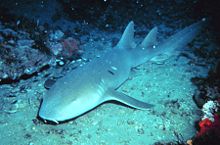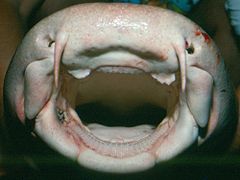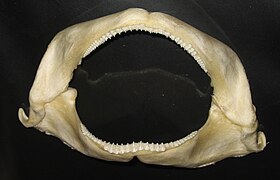Nurse shark
| Nurse shark | |
|---|---|

| |
| Scientific classification | |
| Kingdom: | |
| Phylum: | |
| Class: | |
| Subclass: | |
| Order: | |
| Family: | |
| Genus: | |
| Species: | G. cirratum
|
| Binomial name | |
| Ginglymostoma cirratum (Bonnaterre, 1788)
| |

| |
The nurse shark (Ginglymostoma cirratum) is a shark in the family Ginglymostomatidae. Nurse sharks can reach a length of 3.08 m (10.1 ft).
Taxonomy
The nurse shark family name, Ginglymostomatidae, derives from the Greek: from γίγγλυμος meaning hinge and στόμα meaning mouth. Cirratum also derives from Greek, meaning curl or swim. Based on morphological similarities, Ginglymostoma is believed to be the sister genus of Nebrius, with both being placed in a clade that also contains the Pseudoginglymostoma brevicaudatum, Rhincodon typus, and Stegostoma fasciatum.[3]
Distribution and habitat
The nurse shark is a common inshore bottom-dwelling shark, found in tropical and subtropical waters on the continental and insular shelves. It is frequently found at depths of one meter or less but may occur down to 75 m (246 ft). Its common habitats are reefs, channels between mangrove islands and sand flats. It can be seen in the Western Atlantic from Rhode Island down to southern Brazil; in the Eastern Atlantic from Cameroon to Gabon (and possibly ranges farther north and south) and around the islands of the Caribbean.[4]
Description
The nurse shark has two rounded dorsal fins, rounded pectoral fins, an elongated caudal fin, and a broad head. Nurse sharks are brownish in color. Maximum adult length established by reliable reports is 3.08 m (10.1 ft); earlier reports of lengths up to 4.5 m (15 ft) and corresponding weights of up to 330 kg (730 lb) are likely to have been exaggerated.[2]
-
Head
-
Mouth
-
Jaws
-
Teeth
Biology and ecology
Nurse sharks are nocturnal animals, spending the day in large inactive groups of up to 40 individuals. Hidden under submerged ledges or in crevices within the reef, the nurse sharks seem to prefer specific resting sites and will return to them each day after the night's hunting. By night, the sharks are largely solitary; they spend most of their time rifling through the bottom sediments in search of food. Their diet consists primarily of crustaceans, molluscs, tunicates, sea snakes, and other fish, particularly stingrays.
They are thought to take advantage of dormant fish which would otherwise be too fast for the sharks to catch; although their small mouths limit the size of prey items, the sharks have large throat cavities which are used as a sort of bellows valve. In this way nurse sharks are able to suck in their prey with a short, violent influx of water. Nurse sharks are also known to consume algae and coral, although this may be the by-catch caused by their method of eating.[5]
Nurse sharks have been observed resting on the bottom with their bodies supported on their fins, possibly providing a false shelter for crustaceans which they then ambush and eat.[4]
Nurse sharks are able to respire while stationary by pumping water through their mouths and out gills.
It was shown that compared to sharks such as the shortfin mako shark, nurse sharks only use about eighteen percent of the energy a more active predatory shark would use. Due to their lower metabolic rates as well as their ability to have relatively larger litters of pups that grow faster compared to the offspring of other sharks, they are often one of the most common shark species in tropical to sub-tropical waters.[6][7]
Reproduction
The mating season runs from late June to the end of July. Nurse sharks are ovoviviparous, meaning the eggs develop and hatch within the body of the female where the hatchlings develop further until live birth occurs. The gestation period is six months, with a typical litter of 21–29 pups.[4] The mating cycle is biennial, as it takes 18 months for the female's ovaries to produce another batch of eggs, during which time, cannibalistic behavior can occur. The young nurse sharks are born fully developed at about 30 cm long in Ginglymostoma cirratum. They possess a spotted coloration which fades with age.
Interaction with humans
The nurse shark is not widely commercially fished, but because of its sluggish behaviour it is an easy target for local fisheries. Its skin is exceptionally tough and is prized for leather; its flesh is consumed fresh and salted and its liver is utilised for oil. It is not taken as a game fish. It has been reported in some unprovoked bites on humans but is not generally perceived as a threat. Divers have often provoked the shark, however, by grabbing a motionless specimen by the tail.[8]
Juvenile nurse sharks are sometimes sold in the saltwater aquarium trade.[9] However, since nurse sharks attain lengths in excess of ten feet they are far too large to be kept in home aquaria.[9] In an article for Aquarium Fish Magazine, Scott W. Michael criticizes the ethics of aquarists attempting to keep species beyond their spatial and financial means.[9] He also notes that most public aquaria are not interested in taking specimens that have outgrown home aquaria and that they should never be released into the wild.[9]
See also
References
- ^ Sepkoski, J. (2002). "A compendium of fossil marine animal genera (Chondrichthyes entry)". Bulletins of American Paleontology. 364: 560.
- ^ a b Template:IUCN
- ^ Goto, T. (2001). "Comparative Anatomy, Phylogeny and Cladistic Classification of the Order Orectolobiformes (Chondrichthyes, Elasmobranchii)". Memoirs of the Graduate School of Fisheries Science, Hokkaido University. 48 (1): 1–101.
- ^ a b c Compagno, L.J.V. (1984). Sharks of the World: An annotated and illustrated catalogue of shark species known to date. Food and Agriculture Organization of the United Nations. pp. 205–207, 555–561, 588.
- ^ Edmonds, M. "How Nurse Sharks Work". How Stuff Works. Retrieved 13 February 2015.
- ^ Whitney, Nicholas M.; Lear, Karissa O.; Gaskins, Lindsay C.; Gleiss, Adrian C. (2016). "The effects of temperature and swimming speed on the metabolic rate of the nurse shark (Ginglymostoma cirratum, Bonaterre)". Journal of Experimental Marine Biology and Ecology. 477: 40. doi:10.1016/j.jembe.2015.12.009.
- ^ "Shark with lowest-known metabolism is a sluggish success". Sciencedaily.com.
- ^ Main, Douglas. "Provoked, Nurse Shark Bites Florida Woman And Won't Let Go". Newsweek. Retrieved May 16, 2016.
- ^ a b c d Michael, S.W. (2004). "Sharks at Home". Aquarium Fish Magazine. pp. 20–29.





